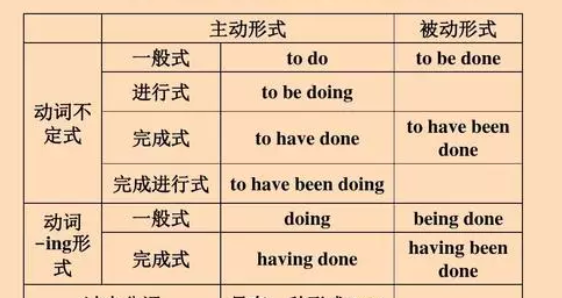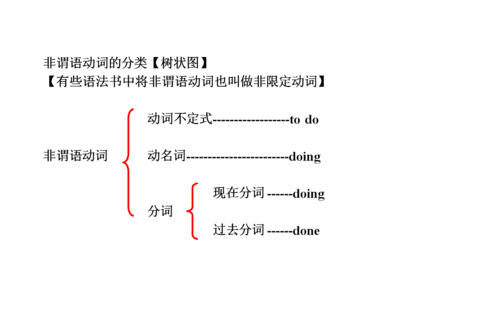本文目录
非谓语动词作状语用英语怎么说
(6)作状语: ①表目的: He
worked
day
and
night
to
get
the
money.
他夜以继日地工作来赚钱。 She
sold
her
hair
to
buy
the
watch
chain.
她卖掉了自己的头发来买那条表链。 注意不定式放句首时,逻辑主语与句子主语要一致: wrong:To
save
money,
every
means
has
been
tried. right:To
save
money,
he
has
tried
every
means.
为了省钱,他使出了浑身解数。 wrong:To
learn
English
well,
a
dictionary
is
needed. right:To
learn
English
well,
he
needs
a
dictionary.
为了学好英语,他需要一本词典。 ②表结果(往往是与预期愿望相反的结果
意料之外):
常放在never
only后 He
arrived
late
only
to
find
the
train
had
gone.
他来晚了,只见火车已经走了。 I
visited
him
only
to
find
him
out.
我去拜访他,只见他出去了。 ③表原因:常放在形容词后面 They
were
very
sad
to
hear
the
news.
他们听到这条新闻非常伤心。 ④表程度: It's
too
dark
for
us
to
see
anything.
太暗了,我们什么也看不见。 The
question
is
simple
for
him
to
answer.
这问题由他来回答是很简单的。 (7)作目的状语:既可以放在句首,也可以放在句尾 To
tell
you
the
truth,
I
don't
like
the
way
he
talked.
说实话,我不喜欢他讲话的方式。

非谓语动词知识点总结及例句
非谓语动词:即不是谓语的动词形式,主要有三大分类:动词的ing形式。
动词的不定式to,do,动词的分词形式(现在分词和过去分词)
非谓语动词可以充当多种成分,如:主语、宾语、表语、定语、状语和宾语补足语。
非谓语动词是历年高考英语的重要考点之一,同时也是较难掌握的难点之一。它贯穿于英语学习和考试过程的始终。但是,只要认真分析、透彻理解、看透本质、准确把握,就一定能在高考中运筹帷幄,游刃有余。

扩展资料:
不定式
1、“to” 是不定式符号还是介词,下列短语中的to 都是介词。
agree to object to close to,come to,lead to,refer to
equal to,familiar to,point to,thank to,devote to,next to,belong to,be used to,look forward to。
2、带to 还是不带to
I have no choice but to give in
I cannot do anything but give in
I saw him enter the classroom
( 但是:He was seen to enter the classroom )
非谓语动词和虚拟语气
你说的是非谓语动词的独立成分-垂悬分词么?引导虚拟语气的时候,句子动词语气也用虚拟语气,其用法符合虚拟语气的语法规则,如provided that you had taken an umbrella ,you wouldn't have been caught in the rain.假如你带了雨伞,就不会被雨淋了,类似非谓语动词有:supposing,providing希望能帮到你

以上就是关于非谓语动词引导,非谓语动词作状语用英语怎么说的全部内容,以及非谓语动词引导 的相关内容,希望能够帮到您。

